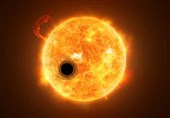Scientists Find 29 Planets Where Aliens Could Be Watching Us
TEHRAN (Tasnim) – Scientists have identified 1,715 star systems where aliens could have discovered Earth by observing our planet’s transit — and within that, 29 planets could be habitable and are uniquely positioned to watch us and pick up on our broadcast transmissions.
According to The Guardian, 46 of those star systems are also close enough to pick up on our radio and TV broadcasts. Humans started intentionally sending radio signals into space to try to contact other forms of life around in the 20th century.
Now, scientists say, if alien life is intelligence enough, they could be eavesdropping on us.
“One way we find planets is if they block out part of the light from their host star,” Lisa Kaltenegger, professor of astronomy and director of Cornell University’s Carl Sagan Institute, told The Guardian. “We asked, ‘Who would we be the aliens for if somebody else was looking?’ There is this tiny sliver in the sky where other star systems have a cosmic front seat to find Earth as a transiting planet.”
Astronomers here on earth have been able to detect thousands of planets in the solar system, mainly by observing when other planets pass in front of the host stars and block some of the light through the telescope, according to The Guardian.
Kaltenegger published her findings along with J.K Faherty in the journal Nature.
“With thousands already detected, our search is entering a new era of discovery with upcoming large telescopes that will look for signs of ‘life’ in the atmospheres of transiting worlds,” the researchers write.
Kaltenegger and Faherty, an astrophysicist at the American Museum of Natural History, used the Gaia catalogue from the European Space Agency to position stars and motions to figure out which stars are in the Earth’s transit zone.
For instance, the star Ross 128 is about 11 light years away and has a planet nearly twice the size of Earth. Researchers say that life on that planet is close enough to observe Earth and could have been doing it for more than 2,000 years. The planet did lose its vantage point about 900 years ago.
“We wanted to use the closest stars,” said Faherty. “When it comes to exploring worlds, the nearest ones to us are going to be the most exciting.”






